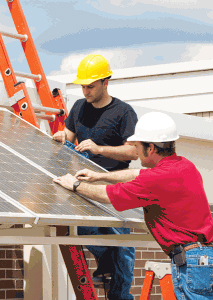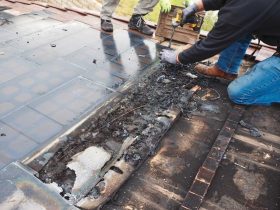
Section 50 of the Canadian Electrical Code covering Solar Photovoltaic Installations has seen dramatic changes in the last year and a half. As a result of this action four new rules have been added, and all but two of the existing rules have changed. Rule numbers in this article are the rule numbers from the 2012 Canadian Electrical Code, and minor editorial changes have been left out.
In Rule 50-004for marking, the “rated open-circuit voltage” has been replaced in Item (b) with the “maximum photovoltaic source circuit voltage.” When calculating this voltage, Rule 50-006 has been expanded giving two options: first, is to multiple the rated open-circuit voltage by 125%; the second, is to calculate the maximum photovoltaic source circuit voltage using the rated open-circuit voltage, difference between 25º C and the lowest expected daily minimum temperature for the installation area, and a voltage temperature coefficient specified by the manufacturer. It is anticipated the second option will only be used for a very large installation where a small difference in the calculated maximum photovoltaic source circuit voltage can have a big impact on the installation cost. A Subrule (3) has also been added to Rule 50-006 indicating the voltage rating for equipment used in the installation must be based on the maximum photovoltaic source and output circuit voltage.
Rule 50-008 is a new rule to Section 50 for voltage drop. This rule gives code users four options. The first option considers the installation acceptable where the conductors are rated at least 125% of the maximum available short-circuit current of the solar photovoltaic system; option two allows up to 5% voltage drop. Options three and four give the designers new methods to calculate acceptable voltage drop. As with Subrule (2) of Rule 50-006, it is anticipated options three and four will only be used for very large installations.
Rule 50-010 now titled Ampere Rating of Photovoltaic Source Circuits has been expanded, adding a Subrule (2) indicating that when applying Rule 8-104 the continuous load is 125% of the rated short-circuit current.
Rule 50-012 covering equipment overcurrent protection has a new subrule requiring the overcurrent protection to be not higher than the allowable ampacity of the photovoltaic source circuit conductors, and the maximum overcurrent protection indicated on the panel nameplates.
Rule 50-014 is a new rule requiring dc arc-fault protection for photovoltaic systems with a voltage of 80 volts or above when installed on or penetrating a building. This requirement is very similar to Section 690.11 of the National Electrical Code, and is reliant on the completion of a new standard for dc arc-fault protection and the availability of equipment.
Rule 50-018 detailing acceptable wiring methods has increased to nine subrules. Wiring methods recognized for the interconnection of panels within an array are extra-hard usage flexible cords, conductors approved as part of an approved panel, rubber photovoltaic underground (RPVU) conductors, and rubber photovoltaic (RPV) conductors where installed in a raceway.
RPV and RPVU are new conductor designations specific for solar photovoltaic installations. In May 2011, a new CSA standard C22.2 No. 271-1 for RPV and RPVU conductors was published.
Subrule (7) requires conductor and cable installations on or above a building to meet the flame spread requirements of the National Building Code of Canada; Subrule (8) requires a raceway for RPV and RPVU conductors installed inside a building; and Subrule (9) allows dc conductors from multiple sources to be installed in a raceway and enclosures with suitable warning notices.
Rule 50-020 now recognizes attachment plugs used with more than flexible cords, and has a new Subrule (2) for circuits operating at over 30 volts requiring tool-operated attachment plugs.
Rules 50-026 and 50-028 are new rules recognizing the great work completed by the subcommittee of New Section 64 Renewable Energy Systems. These rules direct code-users to Section 64 for the requirements for system grounding and for the installation of power conditioning units.
The Section 50 subcommittee is presently working on two new proposals: first, to align the definitions and rule wording within Section 50 with terminology found in the new CSA Standards C22.2 No 61730-1 Photovoltaic Module Safety Qualification Requirements for Construction and C22.2 No. 61730-2 Photovoltaic Module Safety Qualification Requirements for Testing, and the second proposal is to develop specific conductor colour coding requirements for photovoltaic output circuits.










Find Us on Socials